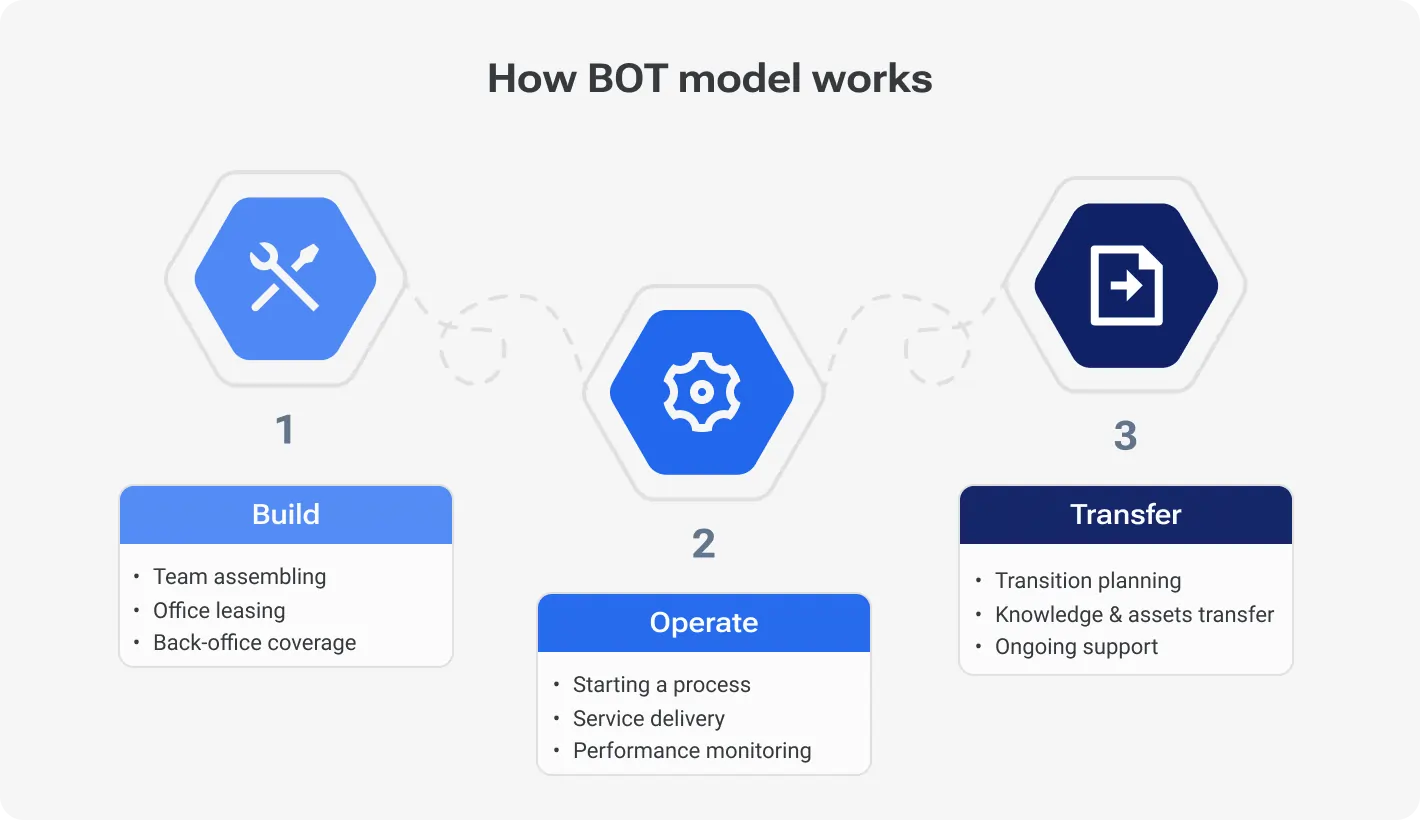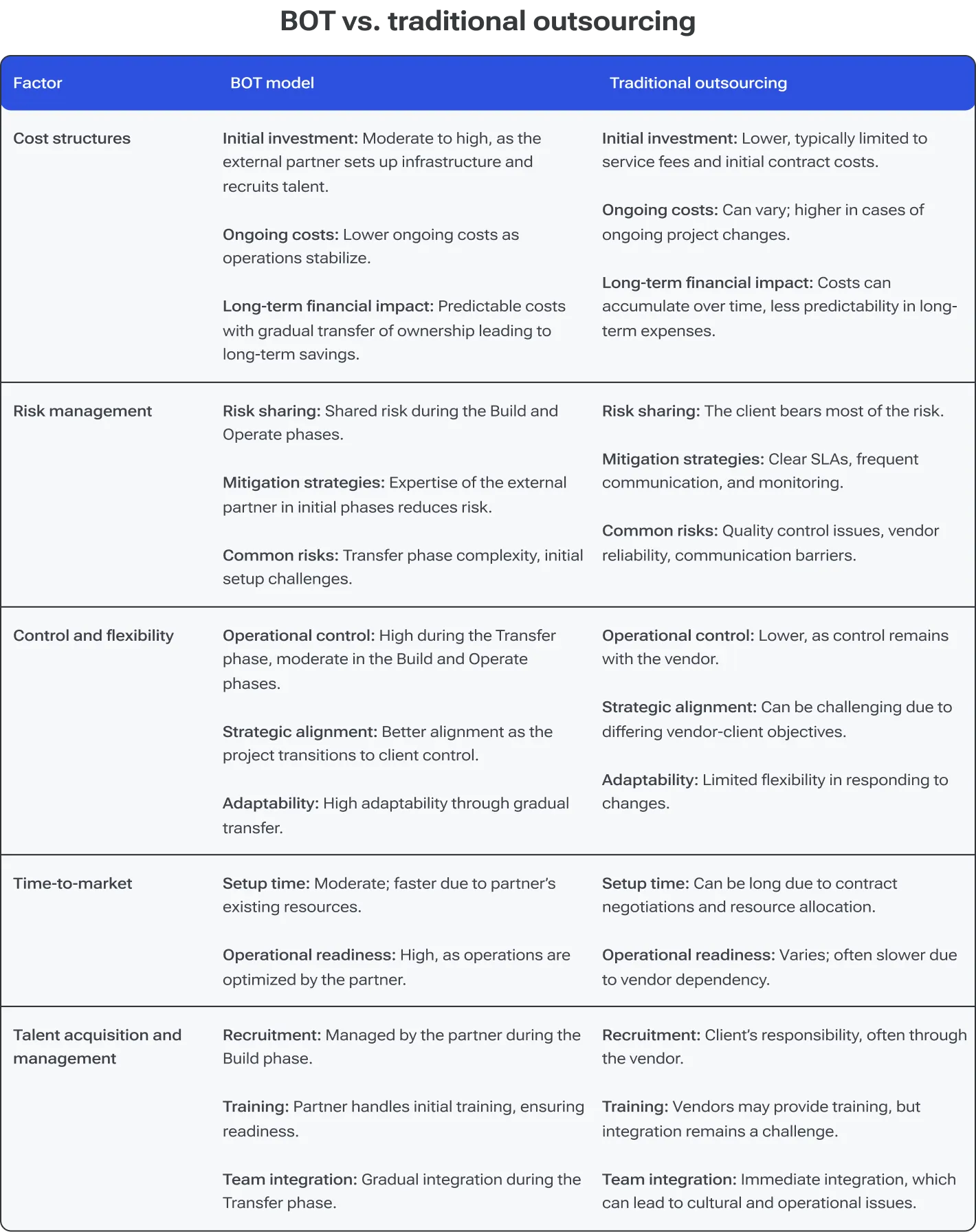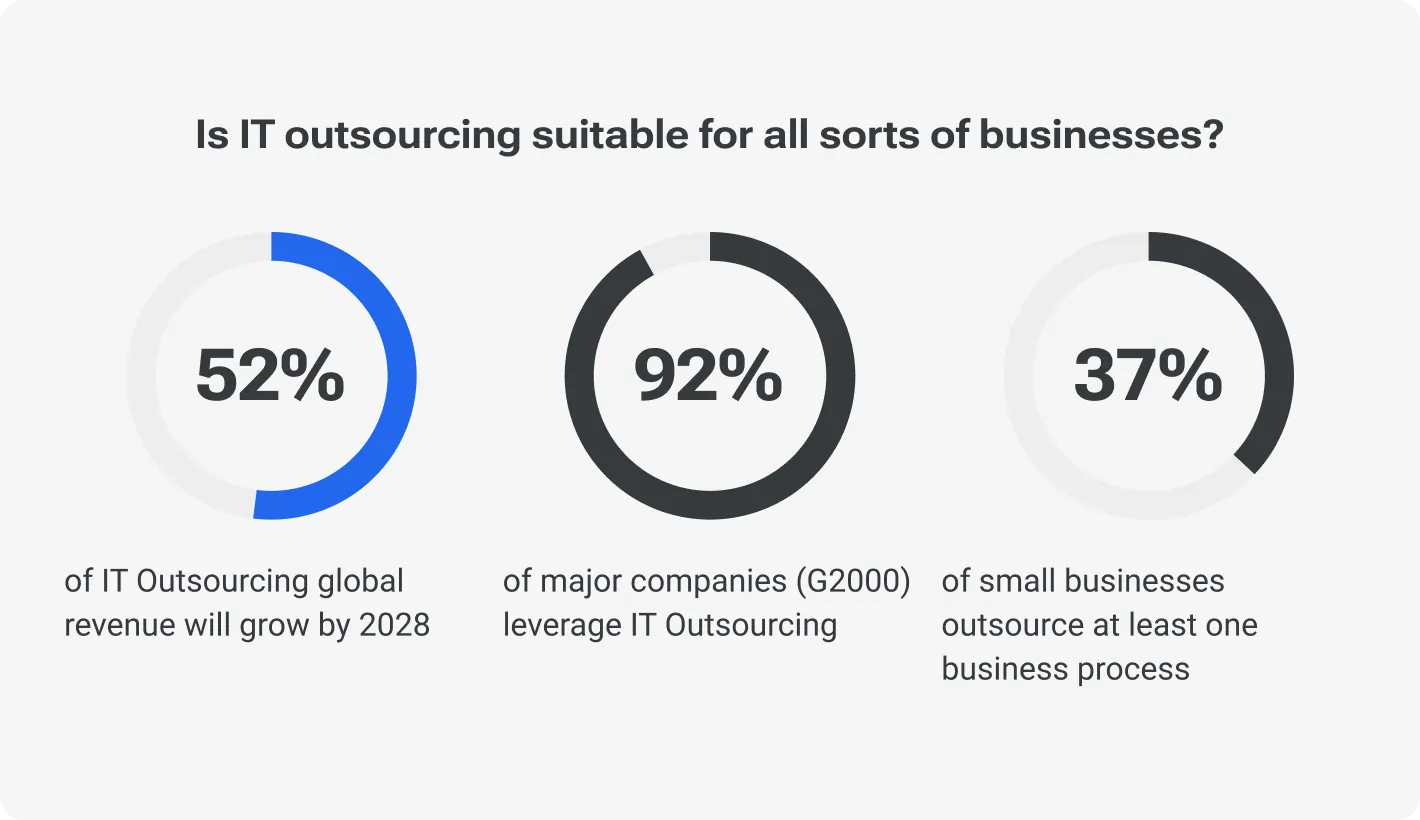Outsourcing to Czechia

How much does it cost to hire developers in Czechia?
Dec 2nd 25 - by Devico Team
Find out how much it costs to hire software developers in Czechia in 2025. Compare hourly rates, roles, and factors that impact pricing.
Hire
Hire by role
Hire Front-end developers
Hire Back-end developers
Hire Full-stack developers
Hire Android developers
Hire iOS developers
Hire Mobile developers
Hire AI engineers
Hire ML engineers
Hire Automation QA engineers
Hire Blockchain developers
Hire Data engineers
Hire Cloud engineers
Hire by skill
Hire JavaScript developers
Hire TypeScript developers
Hire Ruby on Rails developers
Hire React Native developers
Hire Flutter developers
Hire Golang developers
Hire React.js developers
Hire Python developers
Hire PHP developers
Hire .NET developers
Hire Java developers
Hire Laravel developers

BOT
August 05, 2024 - by Devico Team
Summarize with:
The Build-Operate-Transfer (BOT) model and traditional outsourcing are two principal methods in IT project management. BOT implies cooperation with an external partner to build the project infrastructure, operate it, and eventually transfer control to the project owner. For instance, Viber. Rakuten teamed up with ScienceSoft to set up and operate a new development center before taking over full control.
If we zoom in a bit, we’ll get traditional outsourcing. It’s when a business owner hires a third-party vendor to handle specific tasks or entire projects, as seen with IBM’s outsourcing services for various global companies.
Both approaches save time and money. According to a Deloitte report, 59% of companies use outsourcing to reduce costs, while 57% use it to focus on core business functions. McKinsey seconds that: companies using effective outsourcing models can cut operational costs.
This article aims to explore and compare the BOT model and traditional outsourcing. The ins and outs of these models help IT decision-makers, CIOs, CTOs, and business leaders select the right strategy for their projects.
Traditional business development approaches imply scaling through optimization company’s IT strategy. This leads us to a well-established way of delegating specific IT project tasks or entire projects to external vendors. The traditional outsourcing model enhances the client’s flexibility and gives them access to a wider range of expertise. Contracting third-party vendors has three common models:
Offshore outsourcing: Engaging vendors from distant countries to leverage lower labor costs. E.g., an American company hires Polish AI/ML specialists.
Nearshore outsourcing: Partnering with vendors in neighboring countries with similar time zones and cultural affinities. E.g., a US company outsources IT infrastructure management to an Argentinian company.
Onshore outsourcing: Collaborating with vendors within the same country. E.g., the US government contracts Accenture to manage security issues.
Companies engage with vendors in three main ways. However, there are also other nuances of collaboration like pricing model, contract length, and engagement model. We realize these are very abstract concepts. Let's reduce them to more practical issues.
Cost structures: Fixed-price contracts provide cost predictability. For example, in the US, the average cost for a fixed-price project can range from USD 50,000 to USD 250,000, depending on the project's complexity. Time-and-materials billing offers flexibility for evolving project scopes, where clients pay for actual hours worked and materials used. This model can lead to better adaptability but may result in higher costs if not managed properly.
Contract lengths: If the client has a particular and well-defined scope of work, an ideal engagement for them is a short-term contract for a few months. A long-term partnership spanning multiple years and often includes clauses for periodic reviews and adjustments, helping manage evolving business needs and ensuring continuous alignment.
Engagement models: Project-based outsourcing is when the vendor handles entire projects from start to finish. Staff augmentation is when external professionals are integrated into the in-house team to fill skill gaps or increase capacity. This model allows companies to scale resources up or down based on demand.
Cost savings: Outsourcing can significantly reduce operational costs. For example, as we specified at the beginning, a company might save almost 60% by offshoring software development compared to in-house operations in high-cost countries like the US.
Access to global talent: Companies gain access to a diverse talent pool with specialized skills that may not be available locally. This can include expertise in specific technologies or processes. For example, now AI reigns supreme; that’s why many US companies collaborate with skillful AI hubs (Poland, Ukraine, etc.).
Scalability: Businesses can quickly scale their teams based on project needs. This scalability can be crucial during peak project times (for e-commerce projects, for example) or when launching new products (like the AI-based software already mentioned).
From build to transfer: Understanding each phase of the BOT model
Nothing is ideal. There are some roadblocks and challenges every outsourcing client runs into.
Communication barriers: Different time zones, languages, and communication styles can lead to misunderstandings and delays. An example: is a different understanding of the readiness stage: you may consider the ready-to-use product the only possible “ready status”, while your outsourcing partner may assume POC or MVP as the potentially finishing stage. Trust us, this happens more often than you may think it does.
Cultural differences: Never, never touch your earlobe when making eye contact with an Italian. This may seem like a gross insult. Such differences can impact collaboration and team integration. Distinctions in work ethic, holidays, and business practices need to be understood and respected to ensure smooth operations. For instance, Western companies often find challenges in integrating with teams from Asia due to different hierarchical structures and decision-making processes.
Control issues: Outsourcing often requires relinquishing some control over the project to the vendor. This can be managed through robust Service Level Agreements (SLAs) that define performance metrics, quality standards, and regular reporting mechanisms. Implementing these practices ensures that the outsourced team remains aligned with the client's business goals.
So, set clear expectations, maintain regular communication, and foster a collaborative working relationship with the outsourcing partner to even out challenges and enhance benefits.

We continue our outsourcing comparison with the Build-Operate-Transfer model. This is a strategic approach where an external partner initially sets up the project infrastructure, operates it for a defined (by you) period, and eventually transfers ownership and control to you (as a client).
It’s not difficult to understand that the model consists of three connected parts:
Build: In this phase, the external partner sets up the necessary infrastructure, conducts talent acquisition, and develops the required processes and systems.
Operate: The partner runs the operational control: manages the day-to-day operations, optimizing processes and ensuring the project meets performance metrics.
Transfer: Control and ownership of the project are gradually transferred to the client, ensuring an unnoticeable transition and full operational integration.
Phased implementation: The project is developed and matured over the three mentioned phases. This way, the client rest assured the project is stable, runs smoothly, and is ready before full transfer.
Shared risk: The client and the external partner share the risks associated with the initial setup and operational management. This partnership reduces the client's burden and leverages the partner's expertise.
Eventual transfer of ownership: Unlike traditional outsourcing, the BOT model aims for the client to eventually take full control, aligning the project with their long-term goals and internal capabilities.
Risk mitigation: The shared risk approach reduces the financial and operational risks for the client during the initial setup and operation phases. This model leverages the partner’s expertise to handle potential issues and ensure stability.
Faster time-to-market: By utilizing the partner’s existing resources and expertise, projects can be set up and operational faster than building from scratch internally. This speed is crucial for gaining a competitive advantage.
Long-term control: The phased transfer ensures that the client gains full control over the project, allowing for better alignment with business goals and strategies. This gradual handover ensures that the client’s team is well-prepared to take over operations seamlessly.
In the previous section, we stated at least three challenges — there were many things to sound. In this case, we can’t be fast on the uptake since when running properly, the BOT model definitely has fewer pitfalls than the traditional approach (for the client, of course).
Complexity in the transfer phase: The transition of control can be complex, requiring detailed planning and coordination. Ensuring comprehensive knowledge transfer and proper training is essential to avoid operational disruptions.
Initial setup challenges: The Build phase can be demanding, involving significant effort in setting up infrastructure, recruiting the right talent, and developing processes. Partnering with experienced vendors and clear project management strategies can mitigate these challenges.
When leveraging the BOT model, it’s crucial to select clear communication channels and robust project management frameworks. McKinsey once stated that companies that adopt a structured approach to managing BOT projects (and rely on automation) can see a 20-30% increase in project success rates.
Additionally, ensuring that the external partner has a strong track record in BOT implementations can significantly reduce risks and improve outcomes.

The phased approach makes the BOT model more strategic and business-aligned: by the time the project reaches the Transfer phase, the client has a fully operational and optimized project. Basically, a client has partial control throughout the entire project. However, it gains full control in the last phase, ensuring alignment with the business objectives.
Additionally, the BOT model allows for scalability, as the client can expand the project based on their needs, and sustainability, as the initial setup and operation phases are handled by experts.
Traditional IT outsourcing can also align with long-term business strategies, but it often requires more careful management to achieve the same strategic alignment. On the one hand, it offers flexibility and cost savings.
Follow us for more impactful insights.
On the other, it’s a common idea that the lack of control can be a significant drawback. Scalability is achievable but may involve additional costs and renegotiations. Sustainability can be a concern if the vendor’s priorities do not align with the client’s long-term goals.
Consistent quality and performance over the long term turn into a real challenge without significant oversight and management.
Choosing the right model: Businesses should evaluate their specific needs, project scope, and long-term goals when choosing between BOT and traditional outsourcing. For example, companies looking for complete control and strategic alignment may benefit more from the BOT model.
Managing risks: Both models require robust risk management strategies. For BOT, this includes detailed transition planning and continuous monitoring during the Transfer phase. For traditional outsourcing, this involves setting clear SLAs, regular performance reviews, and maintaining strong communication channels.
Talent management: We can’t differentiate a “single best” model since effective recruitment and training are critical for both models. The BOT with its phased approach allows for better integration and alignment. Yet, if you choose traditional outsourcing, it may take more effort to ensure seamless integration and cultural fit.
Ensuring quality and performance: Implementing regular quality checks, performance metrics, and feedback loops is essential. For BOT, this means continuous improvement during the Operate phase, and for traditional outsourcing, it involves frequent vendor assessments and adjustments.
Going from a blueprint to reality takes time. However, the result drives value to the company and to the industry. Let’s run through a couple of such examples.
Viber, a global project in VoIP and instant messaging has 1.17B active users. However, the way to this number lied through different challenges. That’s why Rakuten hired ScienceSoft to develop an app where users will be able to call, text, and send photos using the Internet instead of a cellular network.
For this reason, the contracting company successfully implemented the BOT model to expand development capabilities.
Build phase: ScienceSoft set up the infrastructure, recruited a team of developers, and established secure communication and data handling processes.
Operate phase: For over two years, ScienceSoft managed daily operations, including developing and continuously improving the Viber app across multiple platforms. By the way, Viber initially ran on Android and Windows Phone 7.
Transfer phase: The team and infrastructure were transferred to Viber, who then took full control of the operations.
Challenges: The primary challenges included finding the right talent quickly and ensuring smooth integration of the development processes.
Outcomes: Viber achieved faster time-to-market for new features, hit 1.17 billion users, operational efficiency, and maintained high control over the project. The successful transition allowed Viber to manage its development center independently, enhancing its ability to innovate and respond to market demands.

First Rate, a financial services firm, utilized traditional outsourcing to enhance its software development capabilities. By partnering with an external vendor, First Rate aimed to improve its market presence and operational efficiency.
Scope: The project involved outsourcing the development and maintenance of software solutions used by financial institutions.
Implementation: The vendor managed the entire development lifecycle, from initial design and coding to testing and deployment.
Challenges: The firm faced communication barriers due to different time zones and cultural differences, and control over the project was limited.
Outcomes: Despite these challenges, First Rate benefited from significant cost savings and access to a diverse talent pool. The outsourcing arrangement enabled them to bring new products to market more quickly and efficiently than if they had relied solely on internal resources.
The first step for choosing is to create the matrix of your company/project needs. Include financial parameters (resources), people capability and time available, negotiable and non-negotiable deadlines, etc. Here are some more insights and criteria to help you make an informed decision.
BOT model: Ideal for large-scale, complex projects that require a dedicated team and infrastructure. It allows for a phased approach, ensuring stability before the transfer of control.
Traditional outsourcing: Suitable for well-defined projects with clear deliverables. It works best when the project scope is limited and specific tasks can be easily outsourced.
BOT model: Be ready for higher initial investment. But no fear: you will also have predictable long-term costs. This model can be cost-effective in the long run since the client and contractor share the risks.
Traditional outsourcing: Generally lower initial costs, but long-term expenses can vary. It’s cost-effective for short-term projects but may become expensive for ongoing or indefinite engagements.
BOT model: Offers shared risk with the external partner during the initial phases. This model mitigates risks associated with setup and early operations through the partner's expertise.
Traditional outsourcing: Places more risk on the client, particularly regarding quality control and meeting deadlines. Strong SLAs and continuous monitoring are essential to manage these risks.
BOT model: Aligns well with long-term strategic goals of gaining control over the project. It ensures the transfer of knowledge and capabilities, integrating the project into the client’s core operations.
Traditional outsourcing: Best for achieving short-term objectives and rapid deployment of specific tasks. It allows companies to focus on core business functions while outsourcing peripheral tasks.
BOT model: May take longer to fully implement due to the phased approach, but ensures a robust and stable setup before transfer.
Traditional outsourcing: Can provide quicker results for immediate needs, particularly for well-defined and less complex projects.
If you prefer step-by-step guides, we’ve got you covered.
1. Define project requirements:
Assess the scope, complexity, and duration of your project.
Determine the skills and resources needed.
2. Evaluate financial considerations:
Compare initial investments and long-term cost implications for both models.
Assess your budget constraints and financial flexibility.
3. Assess risk management:
Identify potential risks and your organization’s risk tolerance.
Evaluate the risk mitigation strategies offered by each model.
4. Align with strategic goals:
Determine how each model aligns with your long-term business objectives.
Consider the importance of maintaining control and integrating the project into your core operations.
5. Consider timelines:
Evaluate the urgency of your project needs.
Assess how quickly each model can deliver the desired outcomes.
Communication barriers: Regular and clear communication is essential. Use MS Teams, Slack, etc., and establish frequent check-ins.
Cultural differences: Provide cultural training for teams to ensure smooth collaboration.
Quality control: Implement strict SLAs and continuous monitoring to maintain high standards.
Knowledge transfer: Ensure comprehensive documentation and training sessions during the Transfer phase to mitigate knowledge gaps.
Choosing between the BOT model and traditional outsourcing is a strategic decision that can significantly impact your IT project’s success.
When you are on the fence, it’s pretty difficult to make an informed decision. Here are key points for this reason. The BOT model offers structured phases, shared risk, and long-term control, making it ideal for complex and large-scale projects. Traditional outsourcing provides cost savings, flexibility, and rapid deployment, suitable for well-defined, short-term projects.
Determine your project scope, what budget you can allocate, what risk you can tolerate, set strategic goals, and timelines — all these steps are crucial in making the right choice.
However, navigating this complex terrain doesn't have to be a solitary journey. Devico houses a team of seasoned IT outsourcing professionals with unparalleled expertise in both BOT and traditional models. We understand the nuances of each approach and can guide you through a comprehensive needs assessment to determine the optimal strategy for your specific project.
Outsourcing to Czechia

Dec 2nd 25 - by Devico Team
Find out how much it costs to hire software developers in Czechia in 2025. Compare hourly rates, roles, and factors that impact pricing.
Outsourcing to Czechia

Nov 25th 25 - by Devico Team
Compare Czechia and Poland for software outsourcing in 2025. Discover costs, talent, infrastructure, and which country fits your project best.
Outsourcing to Czechia

Nov 18th 25 - by Devico Team
A complete guide to outsourcing software projects to Czechia, learn about costs, talent, benefits, and how to build successful partnerships in 2025.